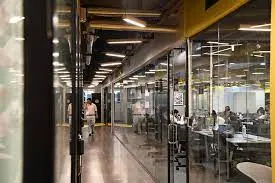A coworking space has emerged as a modern, efficient solution to meet the evolving demands of today’s workforce. Operating on a flexible subscription basis, coworking spaces offer professionals access to dynamic work environments that encourage collaboration and adaptability. Their core strength lies in bringing together diverse individuals and businesses from various industries, fostering a thriving community that supports networking, creativity, and shared growth.
As global work trends continue to evolve, the debate between flexible coworking spaces and traditional office spaces intensifies. Industry leaders and employees alike are no longer passively selecting one over the other; instead, they engage in an informed, self-driven process to identify workspace solutions that best fit their unique operational needs and company culture.
Coworking spaces attract a varied assortment of professionals, ranging from freelancers and remote workers to established enterprises and multinational corporations. These thoughtfully designed spaces offer far more than a desk; they act as catalysts for enhanced productivity, innovation, and collaboration, particularly appealing to creative professionals. Essentially, coworking spaces serve as vibrant hubs that embody the future of work.
In addition to providing flexible and affordable workspace, coworking spaces often feature state-of-the-art amenities, high-speed internet, and tailored services such as conference rooms and event spaces. This combination not only supports day-to-day business operations but also promotes networking events and skill-sharing workshops, enhancing professional development for members. The ability to connect and collaborate within such environments significantly elevates employee satisfaction and retention, positioning coworking spaces as ideal solutions for modern businesses adapting to changing work paradigms.
What Are Traditional Office Spaces?
The concept of a traditional office space has been a cornerstone of business infrastructure for decades. It entails leasing or owning a dedicated physical location for organizations to operate in a controlled environment. Establishing such an office requires extensive planning, including site selection, interior design tailored to company needs, and compliance with building codes and regulations.
Building a functional traditional office involves managing numerous operational aspects such as infrastructure setup, employee amenities, IT systems, and maintenance. It grants full autonomy over the workspace’s layout and environment, allowing businesses to cultivate a unique culture and branding throughout the physical space.
However, traditional office setups often come with challenges such as high fixed costs, limited flexibility in scaling, and a tendency to create isolated work environments. Despite these constraints, they provide structured and predictable settings optimized for consistent workflows and long-term stability, making them a preferred choice for many established companies.
What Are Coworking Spaces?
Coworking spaces have rapidly gained popularity as a contemporary alternative to traditional offices, offering countless benefits that set them apart. These spaces cultivate a vibrant, collaborative atmosphere where professionals from diverse sectors converge, encouraging the free exchange of ideas and fostering innovation.
Flexibility stands as one of the most compelling advantages of coworking spaces. They empower individuals and companies to customize their workspace usage based on fluctuating needs—whether it’s by the hour, day, or month—eliminating the burden of long-term leases. This adaptability perfectly aligns with the increasingly dynamic nature of modern workforces.
Moreover, coworking spaces are strategically located in bustling business hubs, providing excellent connectivity and accessibility for clients and partners. They also offer cost-effective solutions by consolidating expenses such as utilities, maintenance, and administrative support into a single fee. Enhanced networking possibilities, access to community events, and shared resources make coworking spaces attractive to startups, freelancers, and large enterprises alike.
Coworking Spaces and Traditional Office Spaces: The Difference
Coworking spaces serve as shared environments geared toward maximizing collaboration and professional interaction, offering employees ample networking and mentorship opportunities. In contrast, traditional office spaces are typically exclusive to one organization, limiting interaction primarily to internal team members. Despite these differences, both workspace types are designed to optimize productivity and focus.
| Coworking Space | Traditional Office | |
| Varied Workspace | Occupants can freely move within the space and easily scale up or down based on needs. | Movement is limited to a fixed office area with less flexibility. |
| Networking Opportunities | Multiple prospects to connect with like-minded professionals across industries. | Networking generally confined to colleagues within the same organization. |
| Privacy | Private offices alongside open-plan areas offer both confidentiality and collaboration. | Enclosed offices provide a quiet and controlled environment. |
| Productivity | Collaborative atmosphere encourages idea exchange, boosting creativity and output. | Focus on individual tasks, with minimal spontaneous interactions. |
| Professional Environment | Designed for functionality and modern business needs, supporting diverse professionals. | May vary depending on company culture; some offices are formal while others are casual. |
| Brand Identity | Branding possible within managed or serviced offices inside the coworking space. | The entire office space reflects the company’s brand and ethos. |
| Miscellaneous Expenses | All-inclusive fees cover utilities, maintenance, cleaning, and furniture. | Additional costs for utilities, upkeep, and management can increase overall expenses. |
| Administration and Housekeeping | Facility management handles administrative tasks, cleaning, and security. | Managing these tasks may divert focus from core business activities. |
| Tenure | Customizable short-term plans ranging from daily to monthly options. | Typically requires long-term commitments through leases. |
Conclusion
Considering long-term benefits and operational flexibility, coworking spaces clearly offer distinct advantages over traditional office setups. They provide an adaptable and scalable alternative that allows businesses to tailor their workspace requirements effortlessly—ideal for companies experiencing growth or fluctuating demands. Unlike fixed-location offices, coworking spaces enable swift expansion or downsizing in alignment with workforce changes.
The ultimate choice between coworking spaces and traditional offices depends on organizational size, specific requirements, and budget constraints. Due to their cost-effectiveness, flexibility, and scalability, coworking spaces are increasingly becoming the preferred option for startups, SMEs, and even larger corporations. When selecting the best workspace, companies should carefully evaluate their team dynamics, financial parameters, and operational goals to ensure alignment. Numerous office space for rent in Noida offer coworking solutions at competitive prices, catering to a wide array of business needs.
Additionally, if you wish to explore more options about How to Spot a Hazardous Tree on Your Property, please visit our Real Estate category to get comprehensive insights and resources.



